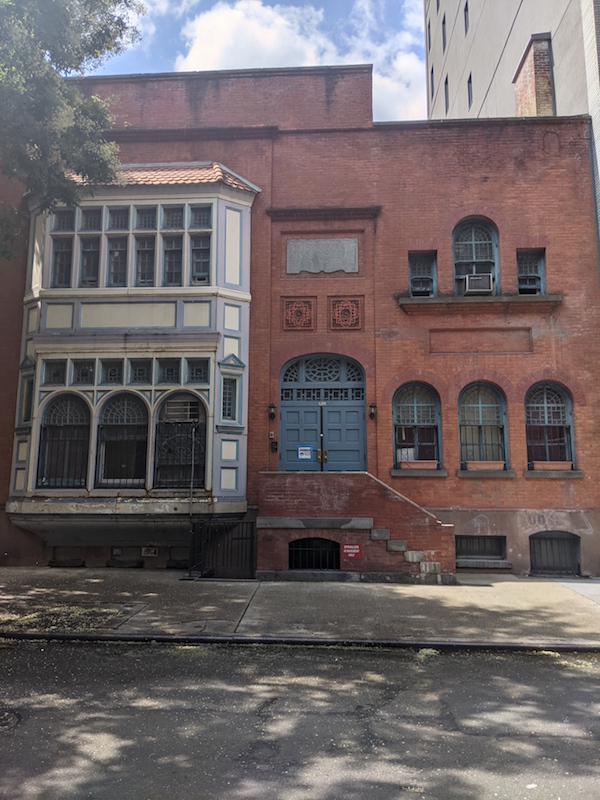
TEXT BY CLAUDIA CAPLAN, PHOTOS BY PAUL GRONCKI | The block of W. 16th St. between Sixth and Seventh Aves. is fortunate to have one of the first examples of Queen Anne architecture in Manhattan, designed by architect Sidney V. Stratton. It is located at 120, and is designated a landmark structure. Its history is one of great service to the community as it was founded as The New York House and School of Industry.
In March of 1850, a group of approximately 50 wealthy women met in a hotel to discuss the plight of indigent females. Among them was Catharine Beecher—who urged that the best way to help these women was not to dole out money which would soon be spent, but to train them to earn their own income. She advocated the establishment of sewing classes.
“Where is trained handicraft more important than in making, mending, and preserving the clothing of a family?” she asked. From this meeting the House and School of Industry was founded. It was a startling concept. Society women at the time tended to donate their time and money to religious outreach projects in an attempt to relieve the poor. Charities that focused on the training and education of the poor would not become widespread until the social reform movement late in the century and the advent of the settlement houses.
One of the original leaders of the institution was Catharine Maria Sedgwick, an author. After she published a moving appeal for donations, money poured in. The charity touted its noble cause “to afford to infirm and destitute females employment in needlework” and to ‘lighten the burden of poverty and to lessen the chances of vice.’ Women were taught everything from basic needlework to highly decorative and delicate work for wedding gowns and trousseaus.

The building we recognize as 120 W. 16th St. was built in 1878 to replace a wooden structure on that site. By that time, the House of Industry was among the favored charities of New York’s most elite socialites. That year, Mrs. Susanna Minturn proposed that Marion Anthon Fish, familiarly known as Mamie, be accepted to the Board of Managers. One of the queens of Manhattan society, Mamie Fish was unanimously approved. Her esteemed name was added to a membership list that read like a roll call of the upper echelon of New York money: Astor, Van Rensselaer, Livingston, Gracie, and DePeyster among them. Membership required more than money, however. All the women were obligated to donate their time as well.

A brief bit of New York history about the Minturns and the Sedgwicks: Robert Bowne Minturn, Susanna Shaw Minturn’s husband, was a Columbia University graduate and an owner of clipper ships as well as vice president of the Denver and Rio Grande Railroad. His parents had donated land for what became Central Park. Susanna Shaw Minturn’s uncle, Robert Gould Shaw, commanded the first African-American unit in the Civil War (you may have seen his story in the movie Glory). Their daughter, Edith Minturn, married Isaac Newton Phelps Stokes, architect of the St. Paul Chapel at Columbia. You can see them together at the Metropolitan Museum of Art in the vibrant Gilded Age portrait, Mr. and Mrs. I.N. Phelps Stokes by John Singer Sargent. Edith Minturn Stokes was President of the New York Kindergarten Association and she was actively engaged with the House and School of Industry. There is every reason to believe she walked our block. Her sister Sarah married Henry Dwight Sedgwick, descendant of Catherine Maria Sedgwick, and their granddaughter (named for Edith Minturn Stokes) was Edie Sedgwick, Andy Warhol’s muse. Their great-granddaughter is the actress, Kyra Sedgwick.
The House and School of Industry successfully continued its mission until 1951. In 1987, the building was purchased by the State of New York—and in 1990, it was designated a New York City landmark. Today, the New York State Office of People with Developmental Disabilities (OPWDD) operates a residence for the not-for-profit Young Adults Institute here. The YAI Network provides opportunities to people with developmental disabilities and their families. By providing hope to the less fortunate of New York City, they continue the original purpose of this remarkable Queen Anne style building. Nevertheless, there is more work to be done on the building itself.
In July 2021, the residents of 120 W. 16th moved out in order for renovations to begin to make the interior more livable and to deal with the deterioration of the façade over time. The work is expected to take at least six months. It will be crucial for the State of New York who owns the building, the Young Adult Institute, the New York City Department of Buildings and the New York City Landmarks Preservation Commission to work together in order to ascertain that all of the upgrades to 120 W. 16th St. are properly permitted and respect the historic nature of the structure.
Currently, the YAI is working with the New York State Office of Parks, Recreation & Historic Preservation to ensure that restorations will be performed in a manner that returns the building to its former significance as a landmark.
Claudia Caplan is a Degree Candidate in History and American Studies at Columbia University in the City of New York.
Chelsea Community News is made possible with the help of our awesome advertisers, and the support of our readers. If you like what you see, please consider taking part in our GoFundMe campaign (click here). To make a direct donation, give feedback, or send a Letter to the Editor, email scott@chelseacommunitynews.com.

You must be logged in to post a comment Login